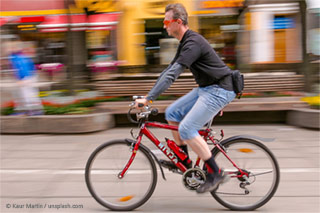Cycling in Germany increased by more than 40 percent between 1996 and 2018. This trend is primarily driven by people with higher levels of education. This is a key finding of two new studies by Dr Ansgar Hudde, from the Institute of Sociology and Social Psychology (ISS) of the WiSo Faculty of the University of Cologne.
For the studies on the connection between bicycle mobility and educational level, the WiSo sociologist had evaluated more than 800,000 journeys made by more than 55,000 respondents. The data came from the German Mobility Panel (MOP) and the Socio-Economic Panel (SOEP) for the years 1996 to 2018 as well as the BMVI study "Mobility in Germany 2017".
According to the studies, urban dwellers in Germany with a high school diploma spent an average of 70 minutes per week cycling in 2018, twice as much as in 1996. In contrast, there was hardly any change in this period for dwellers in less urban areas without a high school diploma. Today, city dwellers with a high school diploma spend three times as much time cycling as dwellers in rural areas without a high school diploma.
The sociologist attributes a large part of the cycling boom to rising education levels. ‘The data show a strong correlation between bicycle mobility and education level,’ said Hudde. ‘There are more and more people with higher education, and they are increasingly cycling. Both trends are currently continuing steadily.’
With regard to city dwellers, Dr. Ansgar Hudde also studied why people with a higher degree of education use bicycles more often than people with lower education levels. One partial explanation is that people with a college degree are somewhat more likely to live in bicycle-friendly cities and neighbourhoods.
However, thorough statistical analysis of the data made it clear that educational differences are also evident within cities and neighborhoods. ‘Individuals with a college degree are nearly 50 per cent more likely to use bicycles than those without a college degree, holding factors such as age, gender, and place of residence constant in the analysis. Overall, the results clearly indicate that it is the educational level itself that leads to more bicycling,’ Hudde said.
Therefore, Hudde explored the question of why the level of education influences whether and how much people cycle. Previous research has shown that people do not choose their means of transport only according to cost or travel time. Rather, they also choose it according to what it symbolizes and what message it sends to third parties. An expensive car can express a lot of wealth and professional success, but little health or environmental awareness. ‘With the bicycle, it’s exactly the opposite. People with higher educational qualifications usually do not run the risk of being perceived as poor or professionally unsuccessful – even if they are on the road with an inexpensive bike. Rather, they can gain status by cycling if they show themselves to be modern, health-conscious, and environmentally aware,’ Hudde explained. ‘In contrast, people with a lower level of education might be more likely to use an expensive car as a status symbol to show that they have “made it”.’
The findings have far-reaching social implications. People with lower education levels are more likely to have less financial resources and, on average, poorer health. As an inexpensive and healthy means of transportation, cycling could mitigate such inequalities – but the opposite is true today. Many cities are promoting cycling and redistributing road space from cars to bikes. At the moment, however, these measures primarily benefit the more highly educated. Dr Ansgar Hudde sums up, ‘If policymakers succeed in making cycling attractive to all, it will mean more livable cities, better health, more environmental protection, and less social inequality.’
The findings of are summarized in two articles published in the Journal of Transport Geography and Sociology:
